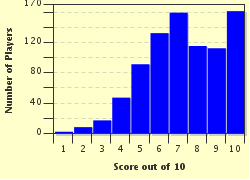Quiz Answer Key and Fun Facts
1. Hillel Slovak was a guitar player and founding member of one of the longest-lasting rock bands still recording and touring in the early 21st century. Sadly, Hillel was only with the band until his death in 1988. He was a big influence on the young man who would take his place in the band, John Frusciante. Which band did Hillel Slovak co-found?
2. Usually regarded as one of the best women in rock history, and indeed one of the best musicians overall regardless of gender, this performer was a symbol of 1960s counter-culture. She was influenced partly by Beat poets, she lived in the Haight-Ashbury neighbourhood of San Francisco, and her drug use was well-known. On October 1, 1970, she recorded the song "Happy Trails" as a birthday greeting for John Lennon, just days before she died. Who was she?
3. The grunge movement of the early 1990s was riddled with brilliant musicians in a constant struggle with their drug addictions. One such victim of heroin addiction was the lead singer of the band Alice in Chains. Who was he?
4. A '90s grunge musician who fell victim to the drug culture of Seattle was this bass player. She first played, recorded and toured with the band Janitor Joe, but she was much more well-known for being in the band Hole. She was planning to leave the Seattle grunge scene following the death of a close friend, but she, too, died before she could leave. Who was she?
5. This next musician was one the best rock band frontmen ever. He sang for a band that took its name from the Aldous Huxley novel "The Doors of Perception". In addition to singing, though, he had a degree in film from UCLA and made a couple of relatively unknown films. He also wrote poetry and published two books of his poems in 1969. Who was he?
6. This musician was born Douglas Glenn Colvin. He moved to Queens, New York from his birthplace of Berlin, Germany when he was a teenager. In New York, he met friend John Cummings, with whom he would form a very influential punk band. He also had a brief career as a rapper, played with a few other bands, released solo work and wrote books. Despite a nearly life-long struggle with heroin addiction, he didn't die until 2002. Who was Douglas Colvin better known as?
7. This man was a pioneer of the grunge genre in the late 1980s and early 1990s with his band Nirvana, and was one of the most famous musicians of his generation. Despite his stardom (or perhaps because of it), he suffered from depression and drug addiction. Though he's remembered for being a very troubled person, he also left behind a legacy as a brilliant and influential musician. Who was he?
8. The lead singer/guitarist of the ska-punk/reggae-influenced alternative rock band Sublime said himself in an interview that he began an experimentation with heroin because it would "aid his artistic creativity". Unfortunately, his 'experiment' caused him to pass away before the band achieved mainstream success. Who was he?
9. This performer's life was tragically cut short by drug use. He was the lead singer of an R&B/rock and roll group, The Teenagers. Though they didn't last long in the spotlight, The Teenagers were actually quite influential for future acts, including The Temptations and The Jackson 5. Who was the leader of The Teenagers?
10. Born Simon John Ritchie, this musician was the bass player of a famous and influential punk band. The group as a whole was often more notorious for their antics than for their talent, but Ritchie and his band mates were still important symbols of the 1970s punk movement. He died not that long after the love of his life, Nancy Spungen, did. Who was Simon John Ritchie better known as?
Source: Author
guitargoddess
This quiz was reviewed by FunTrivia editor
Nannanut before going online.
Any errors found in FunTrivia content are routinely corrected through our feedback system.

